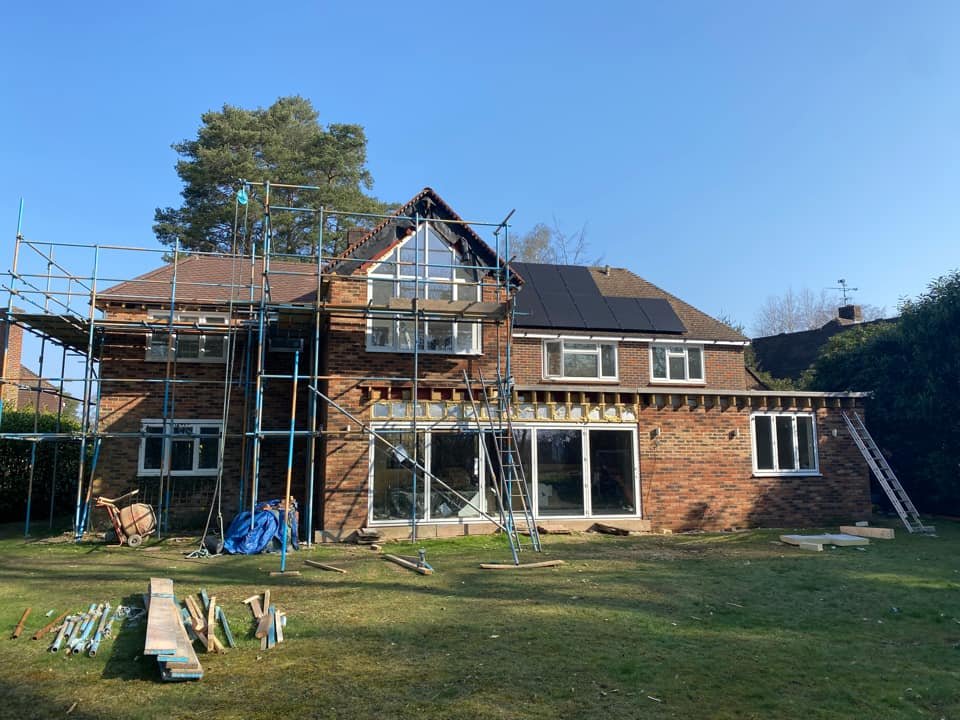Ultimate Guide to a 1950s House Renovation
OUR CLIENT ANNA’S STUNNING 1950S DETACHED RENOVATION
So you’re looking at a 1950s house renovation? Go you! What a great choice! We know a thing or two about architecture, design and how to renovate houses from that period, so let us give you a helping hand on your home-owning journey.
Lucky for you, 1950s houses make for fantastic renovation projects. In fact, our client completely remodelled the interior of their 1950s house and created their dream family home. Take a look at the transformation:
Our client anna’s 1950s renovation - before
…after!
1950s houses are up and coming in terms of style, trends and listing prices so you might be able to snap up a bargain and turn it into the next big thing.
Even if you’ve got a house with full original fixtures and fittings, it doesn’t take too much to modernise them in terms of both design and technology and you can find a really nice balance between honouring the original design and modern-day pieces, too.
If you’re new to the world of home renovation, then you’ve come to the right place. The Fifi McGee website is a go-to for renovation advice, guides and interior design knowledge; see our blog, free advice and online courses. Take a look around! And welcome to the Fifi McGee community.
Renovating a 1950s house – don’t make this mistake ❌
Before we jump in and discuss how to renovate a 1950s house step by step, we’ve got a truth bomb to share.
This renovation mistake cost Neil and I £3.5K so listen up 🥴
Before I trained as an interior designer back in 2016, we were new renovators like you.
We took on our first renovation project (a 1930s house) and we were so naive, terrified of costs spiralling and making stupid, expensive mistakes.
It’s taken hindsight, hands-on experience and my career change to become an interior designer to teach us ‘the right way’ to approach a renovation and this was not it ❌
Neil and I originally had grand plans to build an extension – and called in an architect. It’s the first place to start, right? Wrong.
Little did we know a few months later, we ripped up those architect plans that cost us £3,500 and went our own way with the layout instead.
Our naivety had us instructing an architect too soon. And it’s insanely common for this to happen to newbies like us.
Turns out that last minute decision to ditch our extension plans saved us nearly £80,000 so I guess it served its purpose… but we don’t want this mistake happening to you and your 1950s project.
There’s a simple method to prepare before you hire an architect (if you need one) that will help you renovate the right way and avoid expensive hiccups.
When you finish reading this step by step bungalow renovation guide, a great place to start is by joining our renovation email series where we discuss this in loads more detail. Plus, I share my advice on budgeting and saving money (it’s a completely free email series).
Renovating a 1950s house – a brief history
Neil and I with the lovely anna, who owns this 1950s beauty!
1950s houses have a really interesting history and have earned their place in British cultural history, so you’ll be investing in something super cool. The 50s saw a big turn in the side of morale in Britain as the post-war era slowly lifted and joy returned.
It was a decade of transformation in interiors and in household technology, from central heating to bold, experimental colours and cool geometric patterns.
The 1951 Festival of Britain on London’s South Bank started a period of modernisation which reflected in emerging interiors trends and the proliferation of new housing to home returned soldiers was a perfect experimental place for these styles. Whilst bungalows are common in 1950s houses, layouts of two-storey homes were also a little more daring and made better use of light and space compared to previous generations of construction.
Best of all, the 50s also saw some of our favourite retro designers like Eames, Knoll and Welch so you can take your pick of timeless design classics in your new home.
Are 1950s houses a good renovation investment?
Absolutely! So long as you’re careful with budgeting, you should be able to come out on top with the numbers. Unlike other period properties, you can usually find a 1950s house for a lower price as they’re not immediately sought after by typical home renovators so you’re more likely to make a profit.
Anna’s property (photographed) is particularly impressive – read, expensive! – but there are loads of ex-council 1950s houses that have tonnes of potential too.
The general design style is becoming more popular so fingers crossed your house value is on the rise due to desirability, too. Lastly, you’ll likely spend less on fully renovating a 1950s house as there should be less to do in terms of restoration, electrical and plumbing than with an older property so that’s less for you to find in your budget.
Renovating a 1950s house – what to look out for
Whilst 1950s houses certainly featured a lot of new technologies and design advancements, it’s important to remember that not all of these lasted and there’s a reason for that. Some materials which made an appearance in the 1950s period of transformation were found to be dangerous, some were found to not last very well and some of the styles that emerged were impractical. Sure, we can love these properties for everything that they are, but you’ll want to keep an eye out for certain things that could drain your money and resources if you’re not careful.
Asbestos
Unfortunately, asbestos was a fairly common material used around radiators and pipes in 1950s homes. Hopefully, most of these have been taken out and replaced with a safer alternative, but you need to do your due diligence and check to be on the safe side. If you’re planning a major (disruptive) renovation, it’s worth getting an asbestos survey to save you money (and potentially poor health implications) in the long run.
Poor insulation
While not all 1950s homes have fallen victim to this downfall, poor insulation tends to be common in that period of the property. Although this isn’t a huge no-no when it comes to purchasing your home for renovation, it’s something to be aware of in your overall budget and renovation plan as now would be the best time to upgrade it. Not only can you upgrade insulation during your renovation but make sure the previous lack of insulation hasn’t done any damage. Sometimes this can lead to damp sneaking into the building. If in doubt, get a more thorough survey.
Cast iron plumbing
Cast iron is built to last and was a solid choice of draining pipe material in the 1950s, but 70 years on, some of these pipes are now susceptible to corrosion and need to be replaced. This shouldn’t be a huge job but can be a little costly if they’re past their best or have done any damage from water seepage.
How to renovate a 1950s house – where to start?
I love working with students to help them achieve their renovation dreams in budget
As with any house renovation, it’s hard to know where to start and what to do first. Sure, it can be a lot at first, but breaking the renovation process down step-by-step means you’ll get a better end product with optimal input.
The renovation shouldn’t be too much different to a 1960s home renovation but prioritising the basics like updating the flooring, electrics and lighting means you’re half the way there without any drastic changes. It’s by changing simple things like this that you can update your house to a nice balance of retro and modern without breaking the bank or gutting the whole thing like you’d need to with a Victorian, Edwardian or Georgian house.
If you’ve got a 1950s bungalow, then the process might alter slightly so check our Ultimate Guide to Renovating a Bungalow for even more specific advice and guidance.
Budget
As Neil and I always say to our clients and students, budgeting is the most crucial part of a renovation process. Not that it’s a reflection of how much you’ve got to spend, but more that poor budgeting will be the worst downfall of your renovation plan.
A 1950s house probably won’t need the major work that an older period property would but you still need to plan your budget out carefully, making allowances for hidden surprise costs and changing plans.
Many 1950s houses have smaller kitchens or kitchens that are too out-of-date to function well enough for optimal use so you’ll likely want to remodel the entire kitchen and perhaps the bathroom too if it’s in a similar state. Extensions and conversions will also take up a significant chunk of your budget but they are less common than with older properties so assess this on an individual basis.
I recently shared a video in our free renovation email series revealing how much Anna’s 1950s renovation cost – so be sure to access it if you’re keen to understand how much you can afford.
Layouts
It was a joy working with anna on her 1950s family home
Figuring out your ideal layout in your 1950s property is where the real magic happens. Although they tend to be fairly well configured as it’s still a relatively modern era of building development, there are some tricks you can use to really make your renovation work for you.
This era of building almost universally welcomed in low ceilings and although there’s not a huge amount you can do to change that, adjusting your layout by removing walls for an open plan configuration can welcome more air and light into smaller rooms and balance out having lower ceilings.
On a similar note, you might likely want to widen or open up windows for the same effect so factor this into the new layout.
Design
We’re huge fans of 1950s interior styling and there are buckets of potential to create something modern that pays homage to original retro styling in your new home.
Luckily, honouring your original interior design style but bringing it up to scratch with modern influence opens up a wealth of possibilities. If you’re lucky enough to have original Crittall windows or parquet flooring then these are a goldmine for design inspiration and you can work your design plan around their classic style. Otherwise, you can always reinstate old classics.
Pops of colour were big in the 1950s so put a new take on this by using it in moderation and tastefully.
Definitely get rid of textured walls and ceilings as we can all agree they were never a good look and make for a great opportunity to refresh a wall with a big difference.
Externally, if you’re not comfortable with how the house is looking, a change of colour around the brickwork or even new cladding can make a massive difference without totally changing your existing look.
Plan
This is the stage of your renovation when you can start to tie all the different parts of your (well-budgeted) renovation into something cohesive and plausible. Communication is key here so work with your various builders, contractors and tradespeople to organise who will do what and when and diary the dates with enough time in between to allow for rescheduling.
Finding reliable tradespeople can be tricky at the best of times, but we’ve done our best to put our hard-learned lessons to good use in our How to Renovate a House Course. In this course, you’ll also get the full low down on how to best plan your renovation, avoiding costly errors, and retaining the design vision – even when builders don’t have a clue about the look you’re after!
Shop
our student kathryn’s stunning new kitchen design
Shopping for your 1950s house renovation is going to be great fun as there are so many possibilities to choose from in how you’re going to honour the retro style.
Second-hand shops, antique shops and auctions are great places to find period furniture which you can keep as is or put a modern twist on them. Plenty of high street and online retailers are now also riding the mid-century trend and selling 1950s-inspired furniture and décor pieces which will work really well, especially if you want the benefits of modern design too.
You can really go for it on the very best in design from this decade, such as geometric wallpaper, Eames chairs and block colour textiles.
Luckily, we’ve got you covered when it comes to being budget-conscious. Our free renovation emails contain key ways to rein in your spend.
Renovate!
When the actual renovation stage arrives, it can be the most stressful but also incredibly rewarding. The more work you’ve put into the budgeting, planning and organising, the more successful the renovation will be so now its just fingers crossed all the hard work pays off.
Bit by bit, the renovation falls into place and once you’ve tidied up the sneaky dust and unwrapped protective covers, you get the real reward of seeing your home come into its own.
We’ll leave you with one last piece of advice, and that’s to get all the help you need through this journey. Be that relying on contractors, researching online, taking online courses like ours or even just calling in favours from friends. Remember, many hands make light work (and the renovated home of your dreams).
Don’t know where to start?
Get access to our free renovation email series. Join here! 👇👇👇
Save money, stop costs spiralling!
Avoid pitfalls and compromises
Reduce renovation related stress
We’d love to support you!
We’re passionate about helping first time renovators tackle their projects in the correct order and in an organised way so that ultimately you make the most of your home, your budget and enhance your life when your renovation is finished.
How we can help you:
Start with our free email series A Survivor’s Guide to Renovating
Enrol on our How to Renovate a House Online Course
Happy renovating!
Fifi & Neil
House Renovation Guides
We also have a range of guides to help you get to grips with your renovation:















